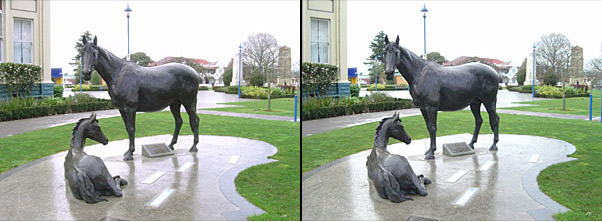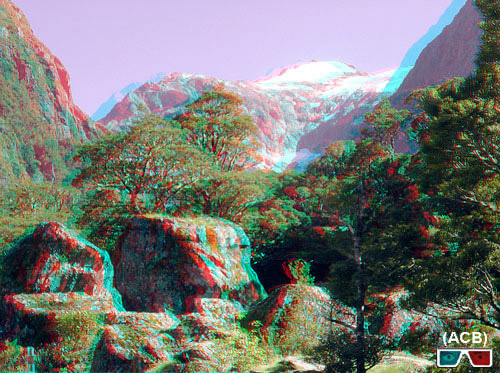Stereoscopic (3-D) Photography
Stereoscopy is a type of photography that involves taking two simultaneous images of the same subject in order to create a three-dimensional view. The two images are known as a stereo pair.
How 3-D Photography Works
The basic principle is straightforward: Take two photographs slightly apart that simulate the separate views of the human eyes, then present each image to the correct eye of the viewer (if you reverse them it won't work properly).
The biggest difficulty in stereoscopic photography is how to present the images. There are several popular methods:
- Anaglyphic, in which one image is superimposed on the other. The images are separated by applying colour filters to each one and using anaglyphic (e.g. red/cyan) glasses to filter the images for the viewer.
- Present the images separately side-by-side, and require the viewer to re-focus their eyes until they merge in a 3-D view.
- Use some form of binocular to present the two images.
- Use polarizing technology (screen and viewing glasses) to separate the images.
- The "wiggle" method, in which both images are displayed in the same space but quickly alternated. This is not true stereoscopic viewing, but does have some advantages such as being useful for people with vision in only one eye.


This image was taken and processed by Marc Dawson using ACB processing (acb3d.com).
Equipment
The simplest way to take stereo pair photographs is to use two cameras mounted side-by-side. The biggest problem with this method is that the photos usually need to be taken exactly at the same time which can be tricky when done manually. Static scenes such as landscapes are easy enough but even the best photographer will struggle to manually capture fast-moving action without a small time difference. This results in images that do not correctly overlap.
Various devices are available to connect two cameras together so both shutters are released with a single button.
For serious enthusiasts, stereo cameras are available that record two images through two separate lenses.
If there is no subject movement, the two photos can be taken with the same camera (i.e. take one photo then move the camera for the next one). Care must be taken to keep the framing consistent.
Skills & Techniques
The main thing to be aware of is the importance of keeping the two images consistent. Apart from the minor differences caused by separation, everything else should be the same — zoom, framing, exposure, etc. Ideally you should use a wide zoom angle. If you are using two cameras, try to make them the same model.
The distance between cameras or lenses should be closer for near objects and further apart for distant objects. A rule of thumb for lens separation is 1/30th of the distance to the object for side-by-side display, and 1/60th for anaglyphic display. For long-range objects such as landscape scenes, the cameras may be many metres apart.
Try to include plenty of distant background. This helps add more depth.
Search the Internet for information about specialist 3-D imaging software. These tools can help you take and process stereoscopic photographs.
When processing images, it can help to crop the edges so objects are not cut off in one view (this leads to an uncomfortable ghosting effect at the edges of frame).
Applications
Most people think of stereoscopic photography as being a novelty but it does have many practical applications, from medical diagnoses to planetary studies. A 3-dimensional image allows the viewer to see and infer more information, such as the distance and relation between different objects.
History
In 1838 Sir Charles Wheatstone attributed the human ability to see in 3-D to "parallax vision", i.e. the way in which two eyes provide slightly different perspectives of the same scene.
The modern stereoscope was invented by Sir David Brewster in 1849, and enjoyed huge popularity well into the 20th Century. Film and television eventually overshadowed this form of visual display.
Anaglyphic 3-D movies became popular in the 1950s but never managed to replace 2-D viewing due to a number of limitations (and of course the annoying glasses).
A number of technologies have been developed to replace the predominant anaglyphic technique, but none have yet gained wide acceptance.
Examples
See some examples of stereo photography in both anaglyphic form and stereo pairs at the 3D NZ Gallery.